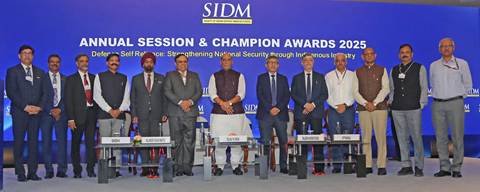Minister wants 50% private sector participation in defence industry
Defence Minister Rajnath Singh expects defence exports to reach Rs.30,000 crore by March 2026, and has called on the private sector to increase its contribution to the domestic defence manufacturing from the current around 25% to at least 50% in the next three years https://www.commerce.gov.in/.
At last count, the defence export was Rs.24,000 crore.
To further increase indigenisation, Rajnath Singh urged the industry to strive towards dominating supply chains and maintenance chains while focusing on indigenous manufacturing of individual subsystems and components, and not just complete platforms http://mod.gov.in.
“In today’s times, when we purchase major equipment from abroad, its maintenance, repair, overhaul, and spare parts management have significant financial implications throughout its life cycle,” he said at the Society of Indian Defence Manufacturers (SIDM) Annual Session, organised on the theme ‘Defence Self-Reliance: Strengthening National Security through Indigenous Industry’, in New Delhi on 27 Oct 2025 https://www.bseindia.com/.
“This puts a strain on our resources and perpetuates dependence on other countries. As a platform contains a large number of components and inputs, indigenous manufacturing of these subsystems can help increase our indigenous content. We must ensure that ‘our soil, our shield’ becomes our first choice,” he said https://www.nseindia.com/.
Elaborating, the Minister underlined, “The objective should not be merely to assemble in India, but rather develop technology-based manufacturing within the country. We must ensure that any technology transfer is effective and also serves as a means of empowering our indigenous industries.’
Stating that no country can progress without innovation and R&D, Rajnath Singh exhorted the industry to develop large-scale, end-to-end technological products as SIDM completes a decade next year https://sbi.com.in/ .
“Through iDEX and ADITI, our young innovators and industrialists are given challenges/problem statements. The industry should now take up a challenge to develop large-scale end-to-end technological products and bring them to us. We will discuss them and fill the gaps. Our effort is to collaborate with the private sector and move forward. If we work together, the entire landscape of the defence sector will transform,” he said, extending the Government’s full support.
He emphasised that the present-day global uncertainties call for an in-depth assessment of every domain, with ‘indigenisation’ being the only way to deal with the challenges emanating from the constantly-evolving defence sector and the nature of warfare.
“The established world order is weakening, and conflict zones are increasing in many regions. It has, therefore, become necessary for India to redefine its security and strategy,” he said https://fieo.org/.
Rajnath Singh pointed out that the Government is creating a level-playing field to enhance defence manufacturing and strengthen the domestic ecosystem, and the industry must make full use of this opportunity.
“We’re striving to ensure that the defence equipment is not just assembled in the country, but a real manufacturing base is established to create the equipment embodying the spirit of ‘Made in India, Made for the World’.
“Numerous initiatives such as the Quantum Mission, Atal Innovation Mission, and the National Research Foundation have been taken to develop a culture of innovation and R&D. Our industry must accomplish what has not yet been achieved in the country,” he said.
India’s defence production has increased to a record Rs.1.51 lakh crore, of which Rs.33,000 crore has been contributed by the private sector. Fiinews.com










